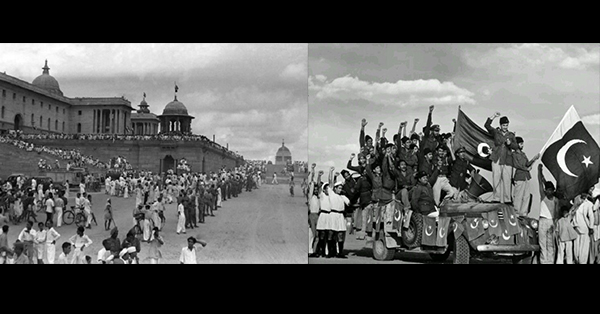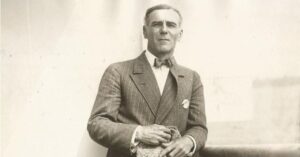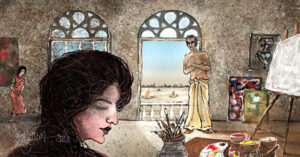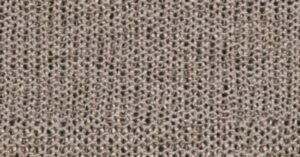A stately black carriage drawn by a pair of majestic white horses. In the carriage, an elegant British lady in a gleaming Chinese satin dress and a sash, accompanying a dashing gentleman in military uniform. A red carpet running from the carriageway to the grand portico of the Sindh Assembly building. And at the entrance to the Assembly, a tall, aristocratic-looking Indian man and an equally elegant lady in a sari standing ready to greet the guests. The visitors alight and the four walk into the building. About half-an-hour later, the four come out and a flag unfurls atop the dome of the building, amid bugles playing and the sound of rejoicing. It is a green flag, with a crescent moon and a single star.
This is living memory. Of Independence Day, 1947. Not August 15. But August 14. Yāum-e-Āzādi. Independence Day, Pakistan.
A nine-year-old girl watched history unfold from the balcony of her family home, a bungalow on Stracham Row in Karachi that shared a wall with the Sindh Assembly building. Today, she lives in Kolkata, having built a life rich in family, friends, achievements, success and contribution to society. Her journey from Karachi to Kolkata via Mumbai, Delhi and Mumbai again mirrors the story of a nation, ancient in history but young in independence.
Shamlu Dudeja, textile revivalist, mathematics teacher, author and philanthropist, was born in Karachi to a professor of Mathematics and a teacher of English. The first of three children, her education started in a Sindhi medium school, though her mother taught in a convent. The reason was interesting – her parents wanted her to stay connected to her roots. Their Sindhi-ness was central to their identity. But this was soon to change, and all of this had to do with what followed that day in mid-August.
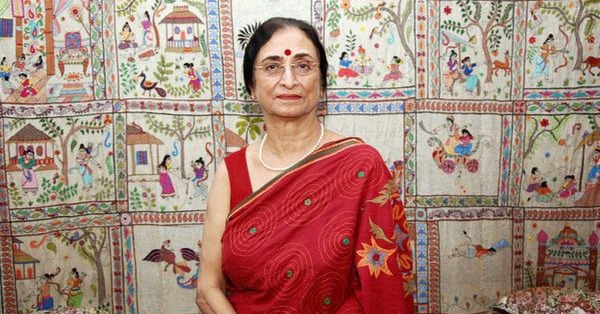
The elegant British couple that Shamlu saw on 14 August 75 years ago was none other than Lady and Lord Mountbatten and the duo that welcomed them was Muhammad Ali Jinnah and his sister, Fatima Jinnah. Shamlu’s memories do not end there, though. “Within 20-30 minutes of the flag being raised, porters who worked in the Assembly started coming out from the building with heavy packages in their arms. They would run out, throw these packages on the lawn and run back inside, only to come back out again with more things. Meanwhile, their wives had stationed themselves on the lawn and were hoarding these packages in baskets and on bicycles. Silverware, cutlery, linens, upholstery, light pieces of furniture – nothing was left behind,” recounts Shamlu.
While roars of rejoicing could be heard all around, the young Shamlu also remembers the tenor of the roar changing gradually to something more dark and angry. In tandem with this change, she saw plumes of smoke beginning to rise up in the distance, in whichever direction she turned.
For about six months before this day, ‘Partition’ had been a word talked about quite a bit in their household. Her father, who headed the Mathematics department at Karachi University, had been deputed to the government, as there was a need for a master statistician. To the young girl, Partition was nothing more than a word. But following this day, Partition was to affect the course of Shamlu’s life, as of a million others. The first was her school – with the closing of all vernacular medium schools due to continued rioting and unrest, Shamlu had to seek admission to the convent where her mother taught.
For about six months before this day, ‘Partition’ had been a word talked about quite a bit in their household. Her father, who headed the Mathematics department at Karachi University, had been deputed to the government, as there was a need for a master statistician. To the young girl, Partition was nothing more than a word. But following this day, Partition was to affect the course of Shamlu’s life, as of a million others.
Her experience there was not pleasant – mostly because her classmates, who were now, over the course of a single night, children of the ruling elite of the new nation. As the atmosphere in the country changed over the next few weeks, her parents, Professor R.R. Kulkarni and Mrs. Kulkarni, reviewed their intention of staying back in Pakistan. Sufi practitioners, they had wanted to remain physically close to their guru, who was based in the interiors of Sindh. But, the changing ‘mahoul’ made them wary. With the blessings of their guru, they decided to leave for India.
Passage was booked on a ship to Mumbai, then Bombay. As post-Partition refugees, they were allowed to carry only a single trunk of belongings. Anything else was considered government property and hence, irremovable. Her mother was adamant about taking her trusted Pfaff sewing machine. Thanks to a kind soldier, she was allowed to board the ship with that bit of extra luggage.
For Shamlu, the momentous journey remains only as a memory of excitement on the high waves, with dolphins jumping next to their ship and beautiful views out of their cabin porthole. Their first days in Bombay were spent with their mama, while their father travelled further to Delhi in search of a job.
“A job at the Ministry of Commerce and Trade came quite easily, especially because Papa had remembered cleverly to take a certificate of appreciation from his superior when he was working for the soon-to-be Pakistan government. Also, officials migrating to Pakistan had created vacancies,” says Shamlu. However, the only accommodation available in Delhi was a stable that would be loosely converted to residential units. Professor Kulkarni called his wife to ask her to stay on in Bombay till he could get more comfortable quarters, but Shamlu’s mother had firmly decided that the family would live together, whether in a mansion or a stable. So she set off for Delhi with their three children, mentally prepared to make a stable their first home in independent India.
However, luck favoured the family. A barsati became available and the next mission was to make it habitable. But this would take time, considering that they had very little funds. Meals were sent over by kind neighbours, as were basic kitchen utensils and some household linens. As a matter of urgency, Shamlu was admitted to Lady Irwin School, and one of the first things her mother had to do was buy yardage to sew new, school-going clothes.
It was time now for her mother’s sewing machine to swing back into action. With the opening of this sewing machine case that had travelled from Karachi with them, good fortune smiled on the family. When a little box of tools was opened, the family found a set of diamond bangles and a ring made of emeralds and diamonds winking up at them. It seems, some day in the past, Shamlu’s mother had taken these pieces off her hands and fingers while embroidering or stitching. It was a matter of great joy and relief for the family in finding these unexpected treasures. One of these bangles was immediately sold off to pay for household items. Finally, the family had a functional, comfortable household. Shamlu tells us that the other bangle was later converted to two pairs of earrings for the two sisters and the emerald ring went to the brother.
With the opening of this sewing machine case that had travelled from Karachi with them, good fortune smiled on the family. When a little box of tools was opened, the family found a set of diamond bangles and a ring made of emeralds and diamonds winking up at them. It seems, some day in the past, Shamlu’s mother had taken these pieces off her hands and fingers while embroidering or stitching. It was a matter of great joy and relief for the family in finding these unexpected treasures.
Life followed its own course for the Kulkarni family. They moved to Bombay after the patriarch’s retirement, Shamlu graduated from Miranda House. With the economy beginning to grow and flourish, there were jobs aplenty for young, educated girls like Shamlu. Other opportunities, including modelling for Handloom House as well as homegrown brands like Lakme and Khatau Sarees. All these were accepted and met with what was now being recognised as Shamlu’s signature elan.
Marriage, a move to Kolkata and children also happened in due course. Always good at Mathematics, with a knack for teaching what was then called ‘Practical Maths’, Shamlu started teaching young children at a local school.
This set off the next course of significant events. A three-day certificate course at the British Council was followed by special training programmes in England and the US being offered to her. Her ideas and expertise in teaching Practical Maths was noticed by Oxford University Press, who approached her to write a series of Mathematics textbooks. She did, and the series, titled COUNTDOWN, was very well received in India. The Pakistan branch of OUP decided to publish this in their country as well. So it came to be that within a year, school children on both sides of the border were studying from Mathematics textbooks written by a girl who was born in Karachi and received her primary mathematical instruction there and had then gone on to get her degrees in Mathematics from India.
It was around this time that Shamlu received an official invitation from OUP to visit Pakistan to see how her textbooks were being taught there. Though her daughter was wary, this was not something that Karachi-born Shamlu could say no to. In fact, she even arranged for her sister, also a teacher, to accompany her. She remembers a lovely visit through the city of her birth. Her only regret is that the guard at the gates of her former home did not let them inside the compound – they could only get the barest glimpse of the bungalow behind leafy trees.
“It gives me an inexpressible feeling of satisfaction, joy and pride that at least for me, in one thing, my India remains without borders. For over 25 years, maths textbooks written by me have been taught on both sides of the border. In fact, a new series – ‘MATHWISE’– has just recently been published in Pakistan. Life has indeed come full circle!” says Shamlu,
There must be many more personal, anecdotal memories of an epoch in the history of the subcontinent, serving as priceless documentation. Shamlu’s life can easily fill the pages of several books. “Yes, it can. Which is why I am now writing down my memoir. I started this as a personal project, but I can now see that it has the potential to interest more than my immediate circle. After all, I have been a witness to history!” she says.
